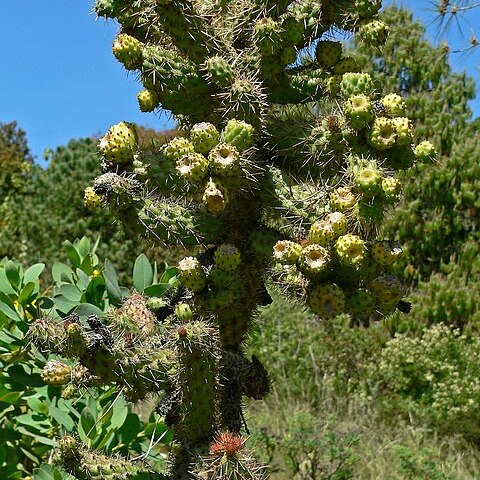Low spreading, many-branched shrub 0.4–1 (–2) m high, to 3 m diam., large plants producing a trunk to 60 cm high. Stem segments whorled or subwhorled, cylindric, 4–15 cm long, 4–5 cm diam., tuberculate, glabrous, dull green to grey-green, terminal segments readily detached; tubercles broadly oval, prominent, rounded, 10–20 mm long, 4–6 mm wide, projecting 4–5 mm. Areoles apical on tubercles, subcircular to obovate, 3–7 mm long, typically 5–9 mm apart, raised, filled with tan wool, and glochids, ageing grey to black. Leaves succulent, terete, tapering to apex, 2–3 mm long. Spines 7–11 per areole, spreading, 10–30 mm long, c. 0.5 mm wide at base; spine sheaths tightly fitting, white to pale tan, glossy. Glochids in a dense adaxial tuft, 2.5–3.5 mm long, light to dark brown. Flowers 25–30 mm diam.; outer tepals reduced, fleshy, green with thulian pink to magenta margins, almost square or slightly broader than long, to 6 mm long; inner tepals thulian pink to magenta, yellowish green near base, narrowly spathulate or narrowly obovate, 12–15 mm long, 6–7 mm wide, the apex obtuse with a short mucro. Staminal filaments thulian pink to magenta above, green below, anthers golden yellow. Style thick, thulian pink or pale yellow and thulian pink near stigma lobes; stigma lobes pale yellow. Pericarpel tuberculate, spiny or spineless. Fruit often proliferating into chains of 3–9 fruits, broadly ovoid to globose, (20—) 25—40 mm long, 20–30 mm diam., the umbilicus usually shallow, weakly tuberculate, with scattered weak spines when immature, fleshy, green at maturity, indehiscent; areoles (20-)25-35. Seeds not seen.
More
Shrubs or small trees, erect, 0.6-2.5 m. Stem segments easily detached, whorled or sub-whorled, green-gray, 4-15 × 3.5-5 cm; tubercles prominent, broadly oval, 1.5-2.5 cm; areoles subcircular to obovate, 4-7 × 3-5 mm; wool tan, aging brown to black. Spines 6-12 per areole, in all but proximalmost areoles, spreading, usually deflexed in abaxial ones, pale red-brown to dark brown, acicular, the longest to 2 cm; sheaths pale yellow-brown, shiny. Glochids in adaxial crescent and few along margin of areole, yellow to brown, 0.5-2.5 mm. Flowers: inner tepals rose to magenta, to 20 mm; filaments yellow-green to distally tinted pink to magenta; anthers yellow, sometimes bearing stigma-tipped, stylelike appendages; style greenish yellow to often pink distally; stigma lobes yellow to white. Fruits usually sterile, often proliferating into short erect chains of 2-5 fruits, green, broadly ovoid to top-shaped, 21-25(-35) × 20-32 mm, fleshy, smooth to shallowly tuberculate, spineless; umbilicus broadly shallow, 5-7 mm deep; areoles (20-)25-35. Seeds rare, globose; girdle smooth. 2n = 22, usually 33.
In Australia, Cylindropuntia prolifera is predominantly naturalised in the subarid and arid inland regions. It is often an environmental weed. In Western Australia it was collected from a private property, where growing with Acacia sp. It is relatively widespread in South Australia, and has been collected from gibber desert where growing in association with chenopods and Senna sp., as well as from mallee sites, and Acacia pendula and bluebush association. In Queensland it has been collected from a dry creek bed in Acacia cambagei scrub, and semi-arid/arid grassland. At Lightning Ridge in New South Wales it is a weed in Eucalyptus populnea subsp. bimbil woodland, on red sandy soil, woodland with small shrubs including Geijera parviflora, and a ground layer with many native herbs and grasses. On Nine Mile Station near Broken Hill it is a weed in subarid shrubland on with Atriplex nummularia, Eremophila sturtii, Dodonaea sp. and Pittosporum phylliraeoides.


